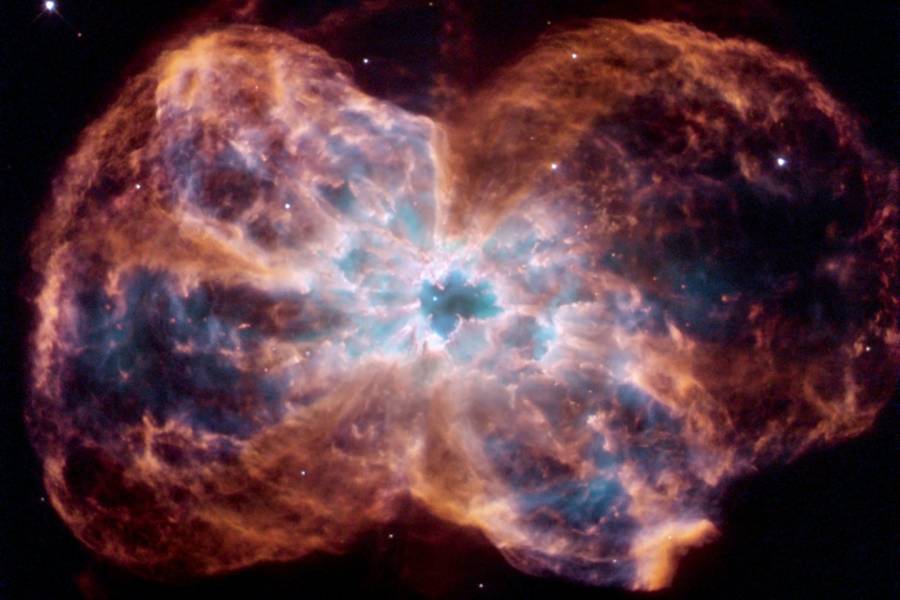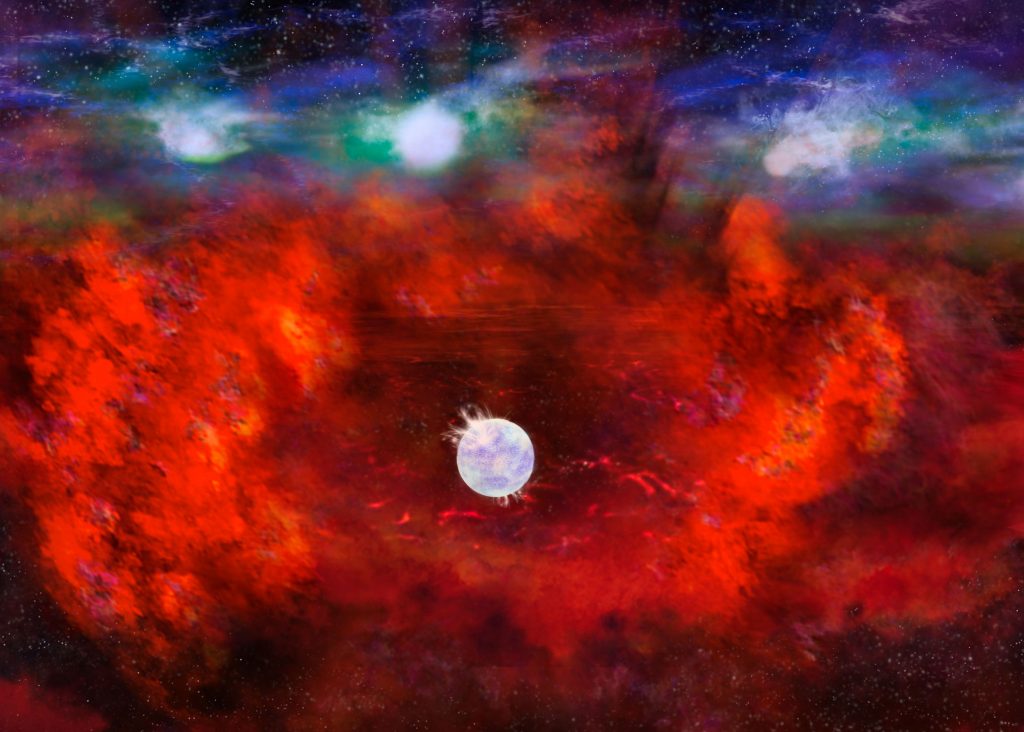Media
Transcript
Today’s science is the kind of reassuring “reality matches expectation” science that sometimes we need on a Monday.
There are lots of never-observed theories in astronomy that we think must be true because there is no other good way to make the math and the models work. For instance, consider white dwarf stars. These tiny objects are the last stage of life for all but the largest stars. They are typically somewhere around the physical size of the Moon and have masses from a few tenths of a solar mass out to a little larger than our Sun. These stars don’t have any nuclear burning in their cores and are supported against gravitational collapse by the ability of electrons to push out against each other, like so many springs between particles.

The thing is that this electron degeneracy pressure can only do so much to support a dead star, and just like springs will compact when put under increasing force, these stars should shrink in diameter as they increase in mass and crush themselves under their own gravity. This weird idea that “white dwarf stars should be smaller in radius as they increase in mass” is such an accepted idea that calculating how the radius changes is a standard homework problem for quantum mechanics students.
We hadn’t really been able to observe this theory because it’s really hard to see objects the size of the Moon at any sort of large distance. Sure, we can see their light, but that hasn’t been enough to measure their radii until now.
In a new paper in The Astrophysical Journal with first author Vedant Chandra, researchers describe how they used data from the Sloan Digital Sky Survey (SDSS) and Gaia to detail out the observed parameters of more than 3000 stars to get at their radii through a trick of relativity.
Light emerging from high-gravity environments gets shifted in color, an effect called gravitational redshifting. Smaller stars with greater mass will exert a larger gravitational pull on the light than a larger, lower-mass white dwarf. This means that the gravitational redshifting of light is directly related to a star’s mass-to-radius ratio. While this may sound almost straightforward, it gets tricky because stars are moving for a whole lot of reasons, and all those motions also shift the light in ways that have to be compensated for.
Trying to subtract out motions due to orbits in binary systems and around the galaxy plus so many other motions is not always possible. Instead, this team, with their more than 3000 stars, assumed that, on average, all the stars have the same random distribution of motions, and if you average all the stars of one radius and all the stars of another radius, those two populations will have the same average motion. Using this logic, they sorted stars by radius, using other techniques to get at that radius, and then looked at the mass-to-radius ratio as a function of radius. Low and behold, our theories proved true, and at least one thing in our reality is exactly as it should be.
But on this particular Monday, it actually wasn’t just one thing that is as it should be.
In another study appearing in The Astrophysical Journal, this time with first author P. Cigan, researchers using the Atacama Large Millimeter/submillimeter Array (ALMA) have, for the first time, detected hints of a neutron star in the heart of the supernova 1987a remnant.

This 33-year-old expanding nebula is still small and dense, and it’s hard to see anything through the gas and dust that makes up this beautiful structure. When the supernova went off, neutrinos were detected, indicating that the remnant in the supernova was most likely a neutron star. Despite many attempts to observe that young, hot neutron star, it hadn’t been seen, and some astronomers were starting to think that maybe something caused that “should be a neutron star” remnant to collapse into a black hole.
It turns out we weren’t patient enough. In these new images from ALMA, a blob of light shines indistinctly through the nebula in a way that is consistent with a young neutron star heating material in the remnant. According to Dany Page: In spite of the supreme complexity of a supernova explosion and the extreme conditions reigning in the interior of a neutron star, the detection of a warm blob of dust is a confirmation of several predictions.
It will be several more years, or maybe even decades, before the remnant expands and thins enough that we can get a good look at this object, but for now, spotting a warm blob in the SN1987a nebula is enough to make us all feel that the universe is behaving according to plan.
Science can be comforting when things work. You look at your data, you run the math, and boom – things are predicted that you can verify.
One extremely satisfying experiment that is currently taking place in Australia is the Desert Fireball Network. In this program, individuals throughout the Outback have cameras pointed at the sky looking for meteors streaking through. When multiple cameras catch the same streak, it can become possible to calculate where any meteorite fragments may be located and to work backward and calculate the orbit the meteoroid was on prior to having its passage blocked by the Earth.

Researchers from Curtin University recently went through images, headed out, and were able to recover debris from two separate meteor falls, one freshly observed and the other from November 2019. They recovered a stunning fist-sized 1.1-kilogram meteorite as well as a smaller 0.3-kilogram meteorite. This ability to see a streak, run the calculations and go find the specific rocks that fell out of the sky in the vastness of Australia’s deserts is pleasing.
Sometimes, pleasing science comes from knowing your software works.
Researchers using the National Astronomical Observatory of Japan’s (NAOJ) Subaru Telescope in Hawaii have taken amazing wide-field images in which they hope to find faint smudges of light from young galaxies. Searching these images by eye is time-consuming and subject to all kinds of human error, so this team has instead trained a neural network to search for them.

In a new paper, again appearing in The Astrophysical Journal, this team, lead by Takashi Kojima, describes a new, ultra metal-poor galaxy their software discovered. Cataloged as HSC J1631+4426, this system is tiny with the mass of only 800,000 Suns and is 430 million light-years away. While not at some great cosmological distance, this young galaxy is made of material largely leftover and unchanged from the earliest times in our universe. It appears to have only 1.6% the heavy element abundance of our Sun, and most of the stars in the galaxy have formed very recently.
This relatively nearby system is a challenge to observe because of its size, but it can be observed with the largest telescopes in the world, and this data should give us new insight into the formation of galaxies. It’s also hoped that as they observe more of the sky, their neural net will be able to uncover more of these smudges of forming galaxies.
Learn More
Astrophysicists Observe Long-Theorized Quantum Phenomena
- Johns Hopkins University article
- “A Gravitational Redshift Measurement of the White Dwarf Mass-Radius Relation,” Vedant Chandra et al., 2020, to appear in the Astrophysical Journal (Preprint on arxiv.org)
ALMA Finds Possible Sign of Neutron Star in Supernova 1987A
- National Radio Astronomy Observatory press release
- “High Angular Resolution ALMA Images of Dust and Molecules in the SN 1987A Ejecta,” P. Cigan et al., 2019 Nov. 19, Astrophysical Journal (Preprint on arxiv.org)
- “NS 1987A in SN 1987A,” D. Page et al., 2020 July 30, Astrophysical Journal (Preprint on arxiv.org)
Rock Stars — Scientists Find Two Meteorites in Two Weeks
Machine Learning Finds a Surprising Early Galaxy
- Subaru Telescope press release
- “Extremely Metal-Poor Representatives Explored by the Subaru Survey (EMPRESS). I. A Successful Machine Learning Selection of Metal-Poor Galaxies and the Discovery of a Galaxy with M*<10^6 M_Sun and 0.016 Z_Sun,” Takashi Kojima et al., 2020 Aug. 3, Astrophysical Journal (Preprint on arxiv.org)
Credits
Written by Pamela Gay
Hosted by Pamela Gay
Audio and Video Editing by Ally Pelphrey
Content Editing by Beth Johnson
Intro and Outro music by Kevin MacLeod, https://incompetech.com/music/


 We record most shows live, on Twitch. Follow us today to get alerts when we go live.
We record most shows live, on Twitch. Follow us today to get alerts when we go live.